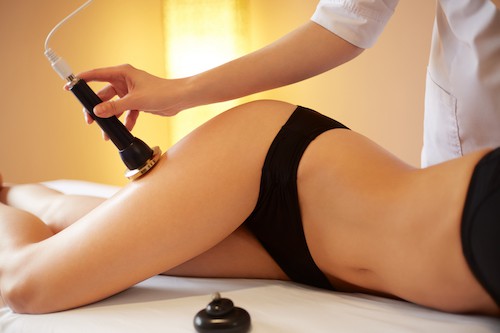Ultrasound Cavitation After Liposuction

One of the most popular body sculpting practices after liposuction is Ultrasonic Cavitation. It is designed to help reduce the fat pockets that can remain after lipo that can’t be addressed through exercise or diet.
But before you book a session, there are a few important things you should know.
A Word of Caution About the
Dangers of Cavitation
Don’t Rush Into Cavitation Too Soon
Many people are eager to “perfect” their surgical results, but cavitation is not something that should be done in the first few weeks or even the first couple of months post-op. In fact, it can do more harm than good if used too early in the healing process.
Liposuction is a significant trauma to the body. The tissues are inflamed, lymphatic flow is altered, and the body is actively healing. Introducing cavitation—a process that deliberately destroys fat cells—too soon can reignite inflammation and disrupt your recovery. The inflammatory cascade that follows cavitation can lead to unwanted fibrosis, lumpy areas, or excessive scar tissue. These are exactly the kinds of complications you’ve likely seen circulating on TikTok or Instagram.
Most clients do not need cavitation within the first 2–3 months. What may seem like irregularities or “fat pockets” are often part of the normal healing process and improve significantly on their own with time and proper post-op care (like lymphatic massage or compression). Manual therapy performed by skilled hands is often more appropriate in the early stages.
Why You Should Only Seek Cavitation
in a Medically Supervised Setting
Another major concern is where and by whom cavitation is being offered. The equipment used in medical spas is typically regulated, calibrated, and operated by professionals who understand post-surgical physiology. Unfortunately, cavitation has also become widely available through non-medical providers—including unlicensed individuals or massage therapists—who are not permitted to use cavitation devices due to licensure.
Inexpensive (read: cheaply made and potentially unsafe) cavitation machines are easy to purchase, which makes them popular in the post-op industry—but without having a medically certified device, this can put clients at risk. Using these devices too early, too aggressively, or on improperly screened clients can increase the chance of complications such as fluid retention, seromas, or scar tissue formation.
If you’re considering cavitation, always wait until you’re at least 12 weeks post-op, and only seek treatment at a reputable med spa or clinic with medically trained staff who understand both the benefits and risks of this procedure.
WHY IS DOING IT TOO SOON
(OR WITH A CHEAP MACHINE/UNLICENSED PERSON)
IS DANGEROUS AND CAN WORSEN RESULTS
The reason or this is that cavitation is a procedure that causes damage (by destroying fat cells). While that sounds good, you need to consider that liposuction (or tummy tuck or other similar procedure) is a type of trauma. The body needs to heal to a certain point before causing more trauma (cavitation). If you don’t give the body time to settle down the inflammation caused by liposuction, then the cavitation will cause the inflammatory process to begin again. The inflammatory cascade is how healing happens. Inflammatory molecules call on the body to send “supplies” to build new tissue.
If you are post op, the last thing you want is for the body to start building a lot of new tissue. Those crazy stories about post op fibrosis on Instagram and Tik Tok? Ask those people if they got cavitation/radio frequency immediately post op…because a lot of places advertise it as appropriate for immediate post op care, but they don’t understand the physiology behind why that is a bad idea. Please hold off until 3 months minimum so you don’t cause even more problems.
Just remember – doing cavitation too soon after lipo can actually cause more problems than it helps. Be sure you are at least 3 months out from surgery before making an appointment for cavitation.
Ultrasound Cavitation FAQ
Does Ultrasonic Cavitation Actually Work?
It works (when using a true medical grade machine like you would find at a med spa), but it is important to keep in mind that the changes are not as dramatic as are often seen on Instagram. The photos posted often have been manipulated. Cavitation does not produce the same results as you would get through surgery.
Cavitation is best used to target areas of fat that do not respond to diet and exercise. Results vary from one person to the next due to the individual’s metabolism, age, tissue structure, hormonal changes, and the area treated.
To get the best results from cavitation, you have to help it along. It is important to follow specific aftercare guidelines to get the most out of your therapy. Read more about this in the aftercare information.
Does Cavitation Help with Fibrosis?
In short, no. Cavitation is designed to act on fat. Fibrosis is a collection of protein that has all stuck together and has not been cleared away from an area of injury and prolonged inflammation. Since cavitation does not destroy protein, it cannot help with fibrosis. Beware of people who tell you otherwise.
How Long Does Ultrasonic Cavitation Last?
Cavitation does not destroy fat cells. It just empties them. This means that if you consume more calories than you burn, the fat cells will start storing more fat again. This means that overeating, lack of exercise, and alcohol consumption can put fat right back into those cells. So, the ultimate longevity of your therapy depends on you.
Who Should Not Get Ultrasonic Cavitation?
People with the following conditions should not get cavitation:
- Metallic Implants (IUD’s, pacemakers, etc.)
- Epilepsy
- Pregnancy
- High Blood Pressure
- Diabetes
- Cancer